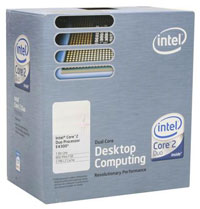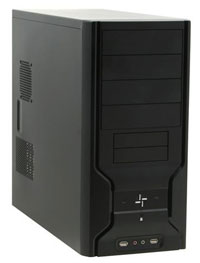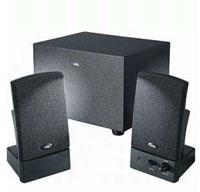Entry Level Intel
Our entry level Intel configuration contains many of the same components as the AMD configuration. The only actual changes are in the choice of motherboard and processor. However, trying to make the systems "equivalent" was simply not realistic. We could either cut the costs of the processor dramatically by going with an older Pentium D offering - not something we would recommend these days - or we end up spending more due to higher prices of Core 2 Duo parts. Intel should be releasing some additional budget offerings in the future, including some single core chips that use the Core architecture. Regardless, if you're looking at Intel-based computers these days we would invariably opt to spend the money and get a Core 2 Duo.
| Intel Entry Level System |
| Hardware |
Component |
Price |
Rebates |
| Processor |
Intel Core 2 Duo E4300 (1.80GHz 2MB Shared) - Retail |
$135 |
|
| Motherboard |
MSI G965M-FI (LGA 775 965G) |
$90 |
|
| Memory |
WINTEC AMPO 2x512MB DDR2-800 (5-5-5-12 3AMD2800-1G1K-R) |
$65 |
|
| Hard Drive |
Western Digital Caviar SE16 WD2500KS 250GB 16MB |
$70 |
|
| Optical Drive |
Lite-On 20X DVD+R LH-20A1P-185 |
$34 |
|
| Case |
RAIDMAX APEX ATX-802BP with 450W PSU |
$65 |
|
| Display |
Hanns-G JC-199DPB 19" 8ms (1280x1024) |
$184 |
$40 |
| Speakers |
Cyber Acoustics CA3001WB 14 watts 2.1 Speakers |
$24 |
|
| Keyboard and Mouse |
Microsoft Comfort Curve 2000 B2L-00047 |
$28 |
|
| Operating System |
Windows MCE 2005 or Vista Home Premium (OEM) |
$115 |
|
| Bottom Line |
|
$810 |
$770 |
 |
Given that price is a major consideration for any budget computer, there was really only one reasonable choice for the processor given the above statements. The Core 2 Duo E4300 is still more expensive than what we would generally classify as an entry level component, but that doesn't mean it isn't worth the money. In pretty much any benchmark you throw at it, the E4300 is going to end up faster than the Athlon X2 3600+ we used in our AMD configuration. Of course, if you were to go out and purchase a $135 AMD part, the performance advantage will likely swing the other way.
 |
Not only do you have to generally spend more money on the processor for the Core 2 Duo platform, but motherboards also tend to cost more than roughly equal offerings from the AMD camp. Since we're using integrated graphics for our entry level configurations, things get even trickier. The IGP offerings for socket AM2 are at present much better than the IGP offerings for socket 775. They perform better, and perhaps more importantly they do so while costing less money. That's not to say that you can't find inexpensive Core 2 Duo compatible motherboards; there are quite a few VIA chipset solutions. For overall quality and reliability, however, we prefer to avoid those if possible, as they can be a bit quirky at times. Motherboards are simply too critical of a component in our view.
Given the choices, we eventually decided to stick with the standard Intel G965 chipset. Graphics performance is subpar compared to the current AMD and NVIDIA offerings, but even then it's still sufficient for most tasks. Intense 3D gaming is not one of those tasks, and even at low resolutions and low detail settings there are so games that won't work properly on this chipset. The X3000 graphics core is supposed to be much improved over previous Intel solutions, but our own opinion is that it remains a lackluster offering. Outside of gaming, however, there are very few applications that require more graphics processing power.
 |
Looking at the G965 motherboards currently available, even the most basic models start at closer to $90, with some of the better equipped models costing as much as $130. The MSI G965M-FI we selected is one of the least expensive offerings but it still does quite well in the features department. Naturally the motherboard supports all Core 2 Duo processors currently available, though it lacks overclocking support in the BIOS at this time. This MSI board also includes FireWire support, something that our entry level AMD platform lacks.
The Gigabyte GA-965GM-S2 would be a better choice for IGP and overclocking, typically reaching moderate FSB speeds. The E4300 processor should be able to run at 2.4GHz (9x266) quite easily and perhaps even 3.0GHz (9x333). Overclocking certainly isn't our primary concern, but the low-end Core 2 Duo chips manage it so well that it deserves mention.
The remaining components are the same, and the bottom line is that the Intel configuration ends up costing about $70 more than the AMD setup. The base performance will definitely favor the Intel platform in processor tests, while graphics tests will favor the 690G IGP over the G965. If you were to spend the same amount of money on both platforms, you could move up to an Athlon X2 5000+ which would certainly put the AMD platform in the lead in virtually all benchmarks. Overclocking would still favor the Intel platform for CPU performance, but for your typical budget PC right now we would give the edge to the AMD platform offerings.














46 Comments
View All Comments
Zepper - Monday, April 23, 2007 - link
You don't have to pay a lot for a decent PSU. The iStar TC-350PD1 is under $40 right now on sale. Even Athenatech has some lower end cases with Fortron/Sparkle PSUs. But you don't act like PSUs are important when testing them separately and then turn around and recommend a junk-bucket even for a budget system..bh.
JarredWalton - Tuesday, April 24, 2007 - link
The case + PSU is $65 shipped. It's actually a pretty decent looking case as well, all told. Now, the iStar costs about $45 shipped at eWiz, which means that you need to find a $20 case that you're happy with or else spend more money. I freely admit that I skimp on PSUs on budget systems, but that's really nothing too surprising. An $80 motherboard with IGP is "skimping", 1GB of RAM is "skimping", etc. They'll all still work fine for most people, but anyone looking to add a GPU, better PSU, etc. quickly vaults into the midrange prices.I supported Dell PCs for several years at another job, and I think they skimp at least as much as anything I've listed here. One year, almost all PCs were fine. Between 12 and 24 months, we had probably 10% fail, many with motherboards and several with PSUs. Past two years, I think the failure rate was approaching 20%, again on mobos and PSUs primarily. I feel a lot worse about cutting costs and quality on a motherboard than I do about going with cheaper PSUs, at least in the budget sector.
JarredWalton - Tuesday, April 24, 2007 - link
Oh, and for that matter I think the LCDs on the low end are suspect as well. I tried to go with ones that are getting favorable ratings, but a lot of people basically seem to say, "Wow - LCDs look cool and it only cost $180! 5 stars!" The thing is, for people that don't go beyond that sort of critique, it probably *is* a five star LCD! That's the same with PSUs and cases. I don't think any serious enthusiast is going to build a decent PC using a budget case and PSU.For the record, the few times I've used Raidmax cases and PSUs (whatever brand they happened to be), I have never had a complaint. Both systems are still running (Athlon XP 2500+) after four years or so. Not bad for a cheap $65 case and PSU. Was I just lucky? Maybe, but that's my experience with budget systems and Raidmax cases. (And also for the record, the people I built those PCs for thought the case looked "l33t" and specifically chose it; I thought it looked gaudy and stupid. No accounting for taste.)
jay401 - Friday, April 20, 2007 - link
That would be the E6320 and E6420. The 50 series doesn't come out until August and will sport higher clockspeeds and higher FSB (1333MHz).
And the question: Any word yet if the Ultra 120 Extreme has been updated to address the concern you guys listed in the review (something about a bracket when trying to mount it on s775 boards)?
Thanks!
redbone75 - Saturday, April 21, 2007 - link
I actually saw the E6320 and E6420 available at Newegg.com on thursday night. Strangely enough they aren't listed there tonight. Both processors are available at zipzoomfly.com, though.jay401 - Friday, April 20, 2007 - link
Dear AMD,This is the final proof you have delayed your R600 GPU series for too long: You didn't even get them out in time for the rarely seen Anandtech Buyer's Guide!
Sincerely,
Disappointed in Delaware
:D